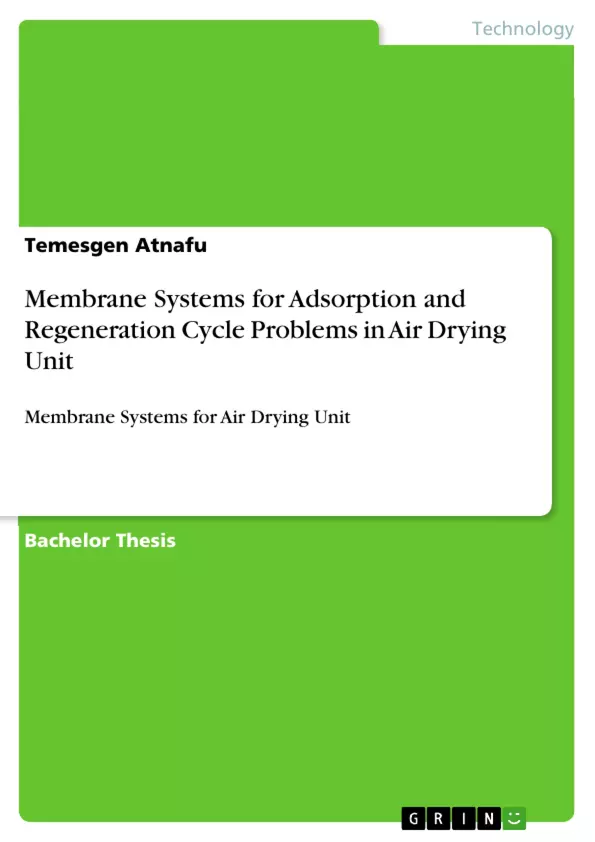Abstract
Main problem in air drying unit is the adsorption and regeneration time. In a dryer adsorption continues for eight hours, after which the desiccant becomes saturated and cannot adsorb further moisture. In this study different types of desiccants are used. Instead of silica gel, activated alumina, zeolite, molecular sieves, activated carbon were used. Membrane dryer are used to solve our regeneration problem. Therefore membrane air dryer is more optimum for commercial processes than the other different dryers. Membrane dryer can be used for 24 hours for one week, so there is no need to standby this equipment. The construction and operation cost of membrane dryer is too simple and can also be used in hazardous condition.
Keywords: Adsorption time, Regeneration time, Activated carbon, Membrane dryer
Inhaltsverzeichnis (Table of Contents)
- Acknowledgement
- Table of Contents
- List of Tables
- List of Figures
- List of Acronyms
- Abstract
- 1. Introduction
- 1.1 Background
- 1.2 Objectives
- 1.2.1 General objective
- 1.2.2 Specific Objectives
- 2. Literature Review
- 2.1 Accessories
- 2.1.1 Compressor
- 2.1.2 After Coolers
- 2.1.3 Separators
- 2.1.4 Prefilter
- 2.1.5 Dryer
- 2.1.6 After Filter
- 2.1.7 Receiver
- 2.2 Air Drying Unit
- 2.2.1 Specification of Drying Unit
- 2.2.2 Inlet Condition
- 2.2.1 Outlet Condition
- 2.2.3 Cycle Time
- 2.2.4 Filter
- 2.2.5 Adsorption Cycle
- 2.2.6 Regeneration & Service Cycle Change Over
- 2.3 Air Dryer
- 2.3.1 Dryer Selection
- 2.4 Expected Outcome
- 2.4.1 Membrane Dryer
- 2.5 Balston Compressed Air Dryers
- 2.5.1 Membrane Air Dryers
- 2.5.2 Application
- 2.5.3 Compressed Air Dryers
- 2.5.4 Application
- 2.5.5 Importance of Moisture Removal
- 2.6 Membrane Filtration Technology
- 2.6.1 Eliminating Downtime and Reducing Maintenance
- 2.7 Hankison Membrane Compressed Air Dryers
- 2.7.1 Advantage of Hankison membrane dryer
- 2.7.2 Choice of Prefilter Package
- 2.8 Parker Membrane Air Dryer
- 2.8.1 Membrane Air Dryers for Analytical Instruments - Dry Air on Demand, Up tp 1,203 1pm
- 2.8.2 Principal Specification
- 2.8.3 Flow Rates (lpm)
- 2.1 Accessories
- Membrane Systems for Adsorption and Regeneration Cycle
- Problems in Air Drying Unit
- Advantages and Limitations of Membrane Dryers
- Performance Evaluation of Membrane Dryers
- Solutions for Overcoming Challenges in Membrane Dryers
- Chapter 1: Introduction
- This chapter introduces the topic of air drying units and the importance of moisture removal in various industrial applications.
- It also outlines the objectives and scope of the thesis, emphasizing the focus on membrane-based drying systems.
- Chapter 2: Literature Review
- This chapter provides a comprehensive overview of existing technologies and research related to air drying units, with a particular emphasis on membrane filtration technology.
- It examines various components of air drying systems, including compressors, aftercoolers, separators, prefilters, dryers, after filters, and receivers.
- The chapter also discusses different types of membrane dryers, their applications, advantages, and disadvantages.
- Specific manufacturers like Balston, Hankison, and Parker are analyzed to provide insights into their membrane air dryer technologies.
Zielsetzung und Themenschwerpunkte (Objectives and Key Themes)
The main objective of this thesis is to study and analyze the problems encountered in air drying units, specifically focusing on membrane systems for adsorption and regeneration cycles. The thesis aims to understand the advantages and limitations of membrane dryers, assess their performance in different operating conditions, and propose solutions for overcoming common challenges.
Zusammenfassung der Kapitel (Chapter Summaries)
This section provides a summary of the main chapters of the thesis, excluding the conclusion and final chapter.
Schlüsselwörter (Keywords)
The main keywords and focus topics of this thesis include membrane systems, adsorption, regeneration, air drying unit, moisture removal, compressed air, membrane filtration technology, Balston, Hankison, Parker, and performance evaluation.
- Citar trabajo
- Lecturer Temesgen Atnafu (Autor), 2008, Membrane Systems for Adsorption and Regeneration Cycle Problems in Air Drying Unit , Múnich, GRIN Verlag, https://www.grin.com/document/208619



